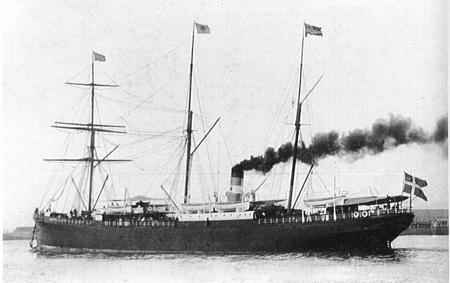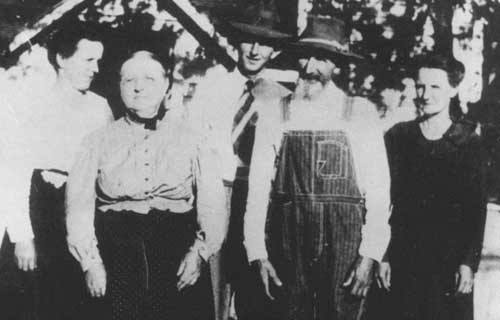| Ole Jakobsen and Karen Marie Jensdatter (they were second cousins) were married at Sønder Asmindrup, Holbæk County, Denmark on 6 May 1879. After they were married, Karen came to live at the Jakobsen farm called Egegård near the village of Stestrup in Kirke Eskilstrup Parish, Holbæk County, Denmark. Karen had been keeping house for her uncle, Niels Hansen at Algestrup in Sønder Asmindrup Parish since her parents and two brothers had emigrated to America in May 1869. | |||||
The old Jakobsen farm, Egegård near Stestrup, Denmark before the buildings burned down. It was in the Jakobsen family from about 1775 until 1920. |
|||||
|
Every family asks the question, "Why did they emigrate?" Every family has their unique reasons, but I have found at least three for Ole and Karen's emigration:
It was decided they would move in April 1880 to Minnesota to be near Karen's parents, Jens and Carrie Hansen who farmed in Aurora Township, Steele County, Minnesota. |
|||||
| On 5 April 1880 Ole and Karen Marie booked passage for America aboard the Thingvalla Line's flagship "Thingvalla". Their intended destination was listed as Owatonna, Minnesota. | |||||
 This is a copy of the original emigrant record kept by the police in Copenhagen 5 April 1880. |
|||||
 The S/S Thingvalla was built in 1873 by Burmeister & Wain, in Copenhagen for A/S Sejl- og Dampskibsselskabet af 1873 (F.W. Kiørebo, Copenhagen). She was launched on 25 October 1873, but delivery was delayed until 20 June 1874. Her first service was in the East Asian trade. In 1877 she was chartered to Compagnie Générale Transatlantique to replace the "Amerique" on their passenger and post route between Le Havre and New York. She was in this service for 7 months before returning to East Asian trade again. Her first voyage with passengers Copenhagen - New York started 25 October 1879. On 16 March 1880 the Thingvalla Line was established and parts of A/S Sejl- og Dampskibsselskabet was converted to become a part of the new company. She commenced her first voyage for the Thingvalla Line, when she departed Copenhagen on 9 April 1880. On 11 April she arrived at Newcastle, England to bunker, and departed for New York on the 14th. On the transatlantic crossing she reported heavy ice on 24 April (more information about that here). The ship lost her screw near Newfoundland and had to be towed to Boston by the Cunard Steamer Samaria for repairs. She arrived at Boston Harbor on 5 May 1880. The passengers disembarked on 7 May. The Thingvalla's 479 passengers were transported to New York either by rail or via the Fall River Steamer Line. Here is a map of the route from Boston to New York. Sources conflict on whether they went to New York by rail or by the steamer line. Here is a picture of the Fall River Line Steamer "Commonwealth". It is not known if this is the exact ship that carried the Thingvalla passengers, but she was in service at the time. The Thingvalla herself arrived to New York on 13 April 1880 with merchandise for Funch, Edye & Co., after a long and very difficult journey. If that was not bad enough, a difficult legal battle ensued over payment to the Samaria for towing the Thingvalla to Boston. On 28 July 1880, the Cunard Steamship Company, owner of the Samaria, was awarded $18,000 for rescuing the Thingvalla. Here are some New York Times articles describing the saga of the Thingvalla's April/May 1880 voyage:
She continued to sail for the Thingvalla Line, and its successor, the Scandinavian-American Line, until on her last voyage September 15th 1898 sailing from Stettin to Copenhagen, Christiania, Christiansand and New York. She was sold in 1900. The above information is adapted from the NorwayHeritage-project among other sources. |
|||||
|
I recently found a narrative from "History of the West Denmark Lutheran Church 1873-1973, Luck, Polk, Wisconsin" that describes this journey from another couple's perspective: The young couple boarded the steamship Thingvalla in the summer of 1880 to sail to their new home. When the ship was no more than a couple of days at sea, it suddenly lost its propeller and began to drift northward out of the regular shipping lanes and into a sea dotted with huge icebergs. Day after day, week after week, the Thingvalla drifted among the icebergs with storms and squalls buffeting the ship and its helpless passengers and crew. Other ships that had left at the same time returned to Denmark with the distressing news that the Thingvalla had not arrived in America, and there was deep despair among the families of the more than 40 immigrants who had left Denmark on the ship. After six weeks of helpless drifting, the carefully rationed food was gone, and the despairing passengers and crew existed on hardtack. Hope was all but gone
when the stricken ship was sighted by an English steamer, and
noting its signals of distress, came to the rescue and towed
the Thingvalla to a port where repairs were made, and the ship
continued its journey. |
|||||
|
|
|||||
| Ole and Karen's difficult transatlantic crossing ended on 7 May 1880 at Boston, Mass. Here they had to board a train or steamer ferry for New York and from there another train that would take them to Owatonna to her waiting parents. | |||||
Here is the story of how I got it: |
|||||
  Here are the records of Ole and Karen's arrival in Boston, Mass. 7 May 1880. |
|||||
| When Ole and Karen Marie arrived in Minnesota, they lived for a short time with Karen's parents, Jens and Carrie Hansen in Aurora Township, Steele County, Minnesota. On 1 June 1880 the US Federal Census shows Ole and Karen living with Jens and Carrie. Karen Marie was listed as "Mary C." | |||||
 |
|||||
|
They had survived a most miserable month of travel to America. Things did not get any easier for the couple. In October of 1880, Ole secured the Quit Claim deed to the east half of the northeast quarter of Section 7 of Blooming Prairie Township, Steele County, Minnesota. The deed came from a lawyer in Faribault named Rodney Alonzo Mott. They dug a basement and spent the winter of 1880-1881 in this humble dwelling. The following year on 29 April 1881 Ole received the Warranty Deed to the farm and a small house was built over the basement. Ole and Karen Marie worked very hard to clear the 80 acres and to build a new life in America. They had three children, Lena in 1881, Matilda in 1885, and Edmund in 1889. |
|||||
  The Jacobson farm home as it appeared in Ole and Karen Marie's time and as it appears today. The farm is still in the Jacobson family over 120 years later! |
|||||
 The Jacobson family in the 1920's. |
|||||
 Ole and Karen Marie's final resting place at the Danish Baptist Cemetery in Blooming Prairie Township, Steele County, Minnesota. |






